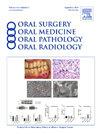Coronoid process: cone beam computed tomography (CBCT) evaluation and proposal of radiographic classification
IF 2
3区 医学
Q2 DENTISTRY, ORAL SURGERY & MEDICINE
Oral Surgery Oral Medicine Oral Pathology Oral Radiology
Pub Date : 2025-02-04
DOI:10.1016/j.oooo.2024.11.006
引用次数: 0
Abstract
Objective
The objective of the study was to investigate the cone beam computed tomography (CBCT) features of coronoid processes in patients without mouth opening limitations and to develop a functional classification of coronoid process considering its relationship with the zygomatic bone.
Study Design
This cross-sectional retrospective study analyzed CBCTs of 204 patients (408 coronoid processes). CBCTs were acquired in a closed-mouth position, capturing the coronoid process and the temporomandibular joint. The scans with temporomandibular joint abnormalities, orofacial trauma or syndromes, and artifacts were excluded. Volume renderings and axial images were evaluated for the shape, surface configuration, coronoid length, condylar length, coronoid/condyle ratio, distance of the coronoid process from the posteromedial surface of the zygoma and its vertical level. The coronoid process was considered hyperplastic when coronoid/condyle ratio was greater than 1.
Results
Most coronoid processes (221) had a triangular shape. The mean length of the coronoids and condyles was 13.85 mm and 16.77 mm, respectively. The mean coronoid/condyle ratio was 0.84. A total of 87 coronoid processes were hyperplastic. The mean distance from the coronoid process to posteromedial surface of zygoma was 15.99 mm, ranging from 5.8 to 27.9 mm. The mean vertical level of coronoid processes in the study sample was 9.6 mm. A novel working classification was developed using the results of this study. The coronoid process was classified as either type I, II, III (a,b,c) and type IV (a,b,c). Type IIIa was the most common (45.83%); followed by type II (29.6%); type I (16.17%); type IIIc (4.41%); type IIIb (3.18%); type IVa (0.49%); and type IV b (0.24%).
Conclusions
The coronoid process can present a wide variety of shapes, sizes, and positions. On the basis of the results, we also propose a working radiographic classification of coronoid process that can help oral and maxillofacial radiologists to identify any abnormalities associated with the coronoid process.
求助全文
约1分钟内获得全文
求助全文
来源期刊

Oral Surgery Oral Medicine Oral Pathology Oral Radiology
DENTISTRY, ORAL SURGERY & MEDICINE-
CiteScore
3.80
自引率
6.90%
发文量
1217
审稿时长
2-4 weeks
期刊介绍:
Oral Surgery, Oral Medicine, Oral Pathology and Oral Radiology is required reading for anyone in the fields of oral surgery, oral medicine, oral pathology, oral radiology or advanced general practice dentistry. It is the only major dental journal that provides a practical and complete overview of the medical and surgical techniques of dental practice in four areas. Topics covered include such current issues as dental implants, treatment of HIV-infected patients, and evaluation and treatment of TMJ disorders. The official publication for nine societies, the Journal is recommended for initial purchase in the Brandon Hill study, Selected List of Books and Journals for the Small Medical Library.
 求助内容:
求助内容: 应助结果提醒方式:
应助结果提醒方式:


